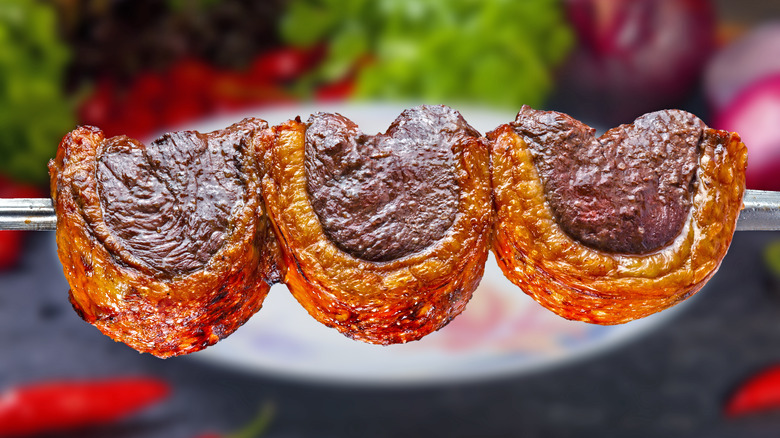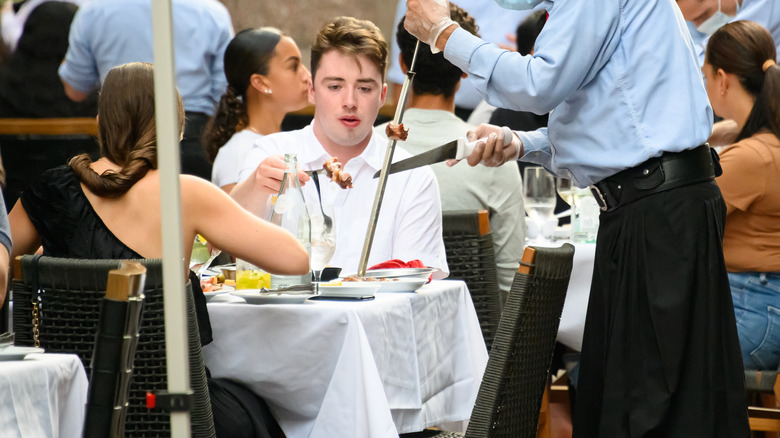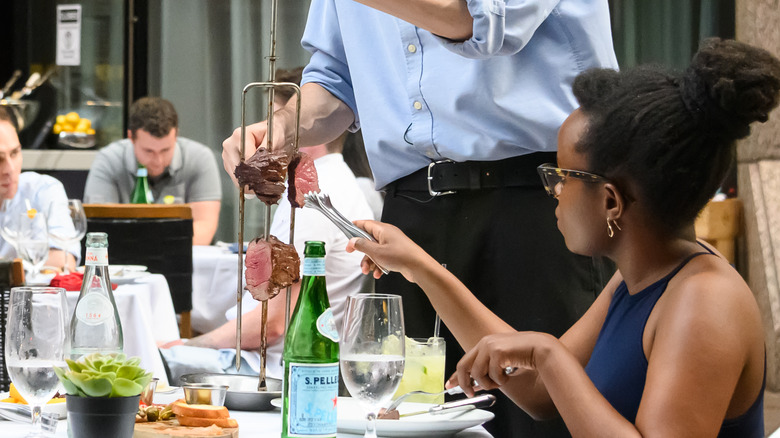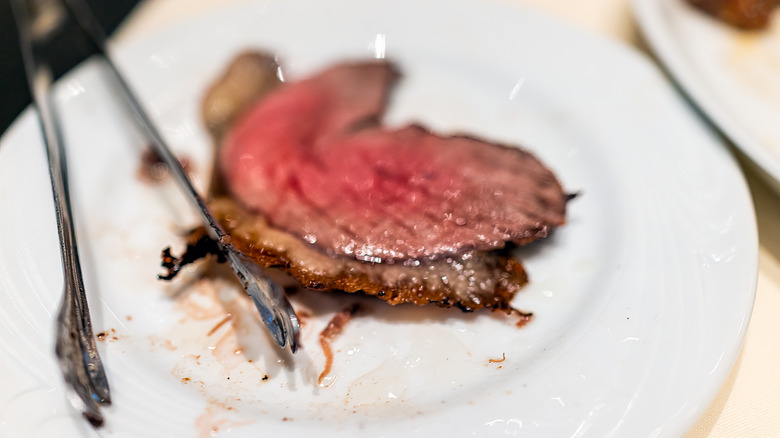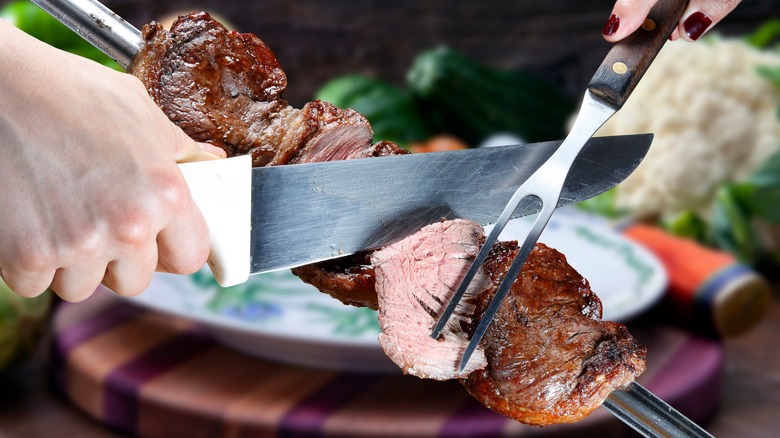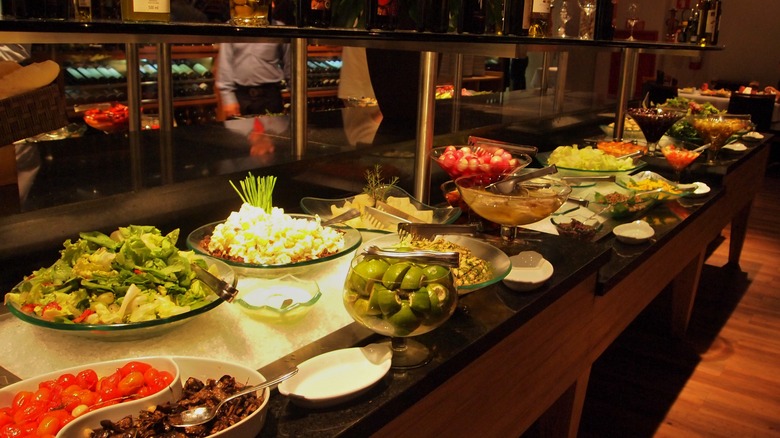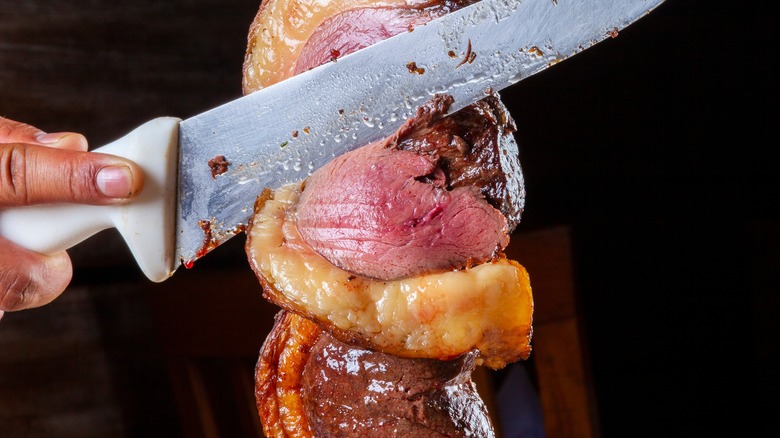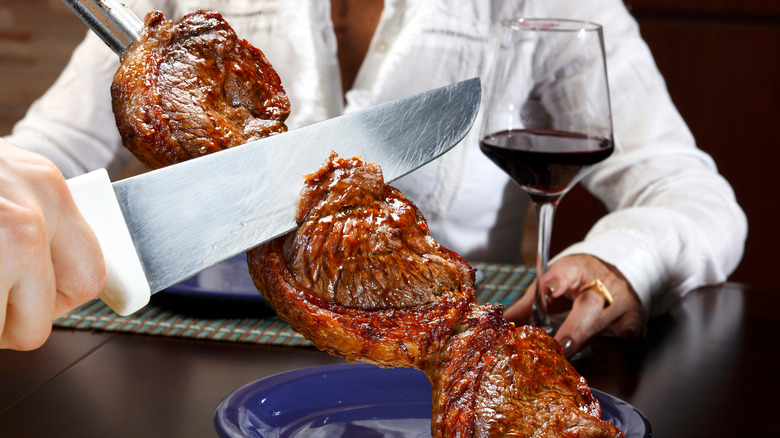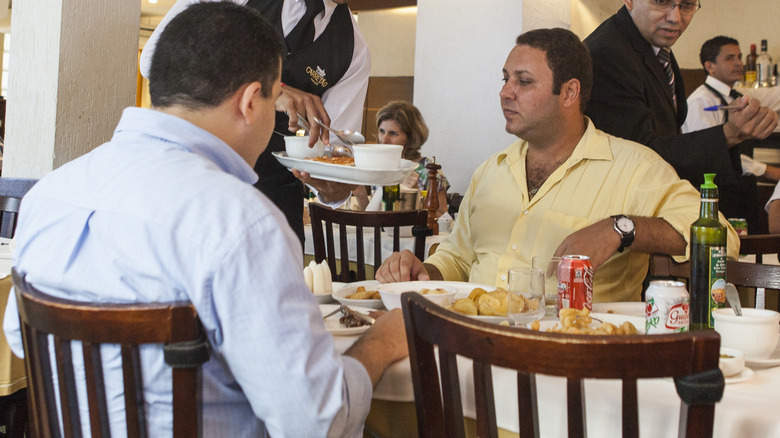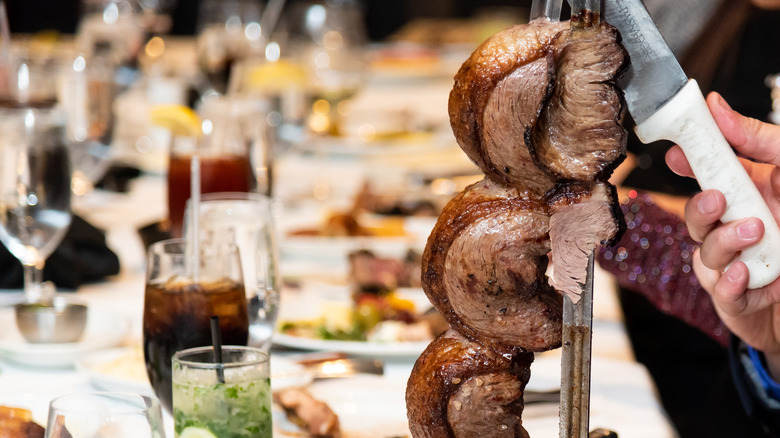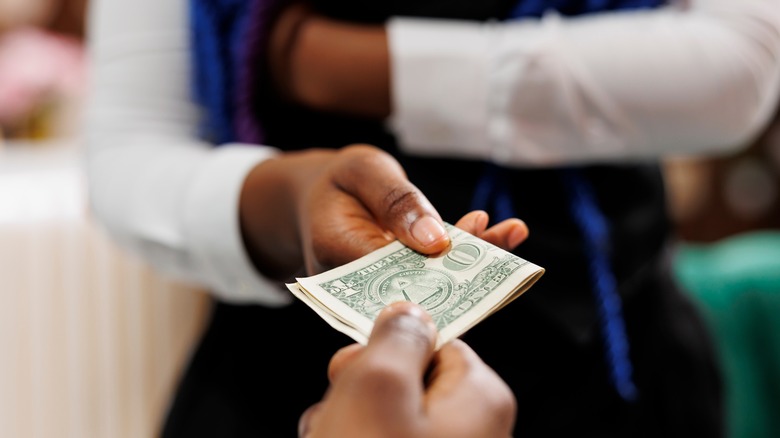Etiquette Rules You Should Always Follow At A Brazilian Steakhouse
Brazilian steakhouses promise a unique dining journey. These paragons of meat are a dream restaurant for steak lovers, especially for fans of grilled meat. Prime cuts of mainly beef are grilled over hot coals and served rodizio style. This entails a rotation of chargrilled hunks of meat on huge skewers paraded around the restaurant dining room. Diners simply choose which piece they like the look of and the server carves a slice right then and there at the table. The sight, aromas, and sense of theater create an unparalleled atmosphere and culinary adventure that has to be tried to be fully appreciated.
There's no need to stand on ceremony when dining at a churrascaria. Some are high-end, however, even those eateries often don't expect patrons to be suited and booted in formal evening attire. Beyond the dress code, the main aim of eating out in this manner is to enjoy your meal. To make the most of what inevitably will turn into a fabulous feast, it's best if you know some guidelines to follow. If you've never dined rodizio-style, read through the etiquette rules you should always follow at a Brazilian steakhouse. They don't simply focus on polite behavior for the sake of it, but act as a prompt so you can get the full benefit of what is to come. From selecting the best Brazilian steakhouse meats to knowing how to handle each slice, there's more to this meat fest than meets the eye.
Don't try and share when only one diner is paying
Above and beyond the nuances of food-sharing etiquette, why would you want to share your meal with someone when feasting at a Brazilian steakhouse? Appetites indeed vary, so some diners might not want to opt for a blow-out package but rather choose a smaller dish. However, once that meat arrives lavishly carved from a skewer fresh off the grill, it might be a different story. Even small or picky eaters are going to find those tender slices hard to resist. Even if your love language is sharing food, when dining in this context of abundance, there's a fine line between genuinely trying a few bites and edging toward a two-for-one deal that isn't on the table.
If you've just realized how ridiculously good picanha steak tastes and want your dining companion to taste it, then no problem. One bite and they may ditch the salad and get on the same meat-eating journey as you. If this turns into full slices or enough bites that it constitutes actually sharing the meal, then that's a no-go in terms of etiquette. One way to avoid misunderstandings is to signal to the meat carvers (aka gauchos) that you're offering a sample or two to your companion. Better this than the embarrassment of being called out for oversharing or acting surreptitiously to sneak food across to another plate. Remember, the response will depend on the establishment, price, and management style.
Be clear if you want more meat or not
In a standard steak restaurant, you look at a menu and order from it. A Brazilian steakhouse is a different deal altogether. What's fundamental to understand is that the gauchos will think you want more slithers of succulent meat unless you tell them otherwise. There's no waving servers over because you've under-ordered or waiting around for dishes to arrive. In most eateries of the sort, you're given some type of colored indicator, such as a token, to guide you in following the expected rules.
When you're full or just need a breather from your meat feast, show the red card, or equivalent. It may have writing on it to say that you don't want any more food at this time. When you're still chowing down and want the skewers to keep coming, then give the gauchos the go-ahead by showing your green card. Remember, even if you have meat on your plate, that won't deter you from being offered more if you're not indicating otherwise. Aside from wasting the time of the carvers, it could prove irritating for fellow diners at your table who have to witness you declining servers time and again.
Use tongs as the meat is carved
When you sit down at a churrascaria you may notice a pair of tongs on your plate. You'll also be given this utensil if you dine at a Korean, Thai, or Japanese barbecue restaurant where you cook meat at a tabletop grill. There's no grilling required by diners when eating steak Brazil-restaurant style, but the tongs are there for an important reason that involves one of the need-to-know etiquette rules you should always follow.
A gaucho rocks up with a gigantic skewer of picanha steak and other meaty delights. You've indicated that you want a slice with your green card and identified which cut you'd like. So far so good. With a huge carving knife in their other hand, the server slices the meat. Letting the serving simply flop onto your plate with juices spraying everywhere isn't done. And there's nothing the carver can do because they are already fully occupied with their hands. The polite move is to grab the slice with your tongs to transport it to your plate as it comes away from the skewer. Gripping onto the meat also helps keep the slice in place so that it's easier to carve. You're not doing the staff a favor — it's actually what is expected. If you don't pay attention, you might find a moment of pause while the gaucho waits for you to grab the tongs.
Don't grab meat off the skewer with your fork
The rodizio-style service of a Brazilian restaurant can feel quite relaxed. Even if it's a pricey place and staff are dressed smartly, ultimately you're tucking into slices of barbecued meat from a skewer. It might be the finest quality beef, but it's not like you're being presented with a small gourmet plate that looks like a work of art. However, don't become so laidback that you commit an etiquette no-no.
If you realize that a slice of meat is about to fall as the gaucho carves it off, your first instinct to save the mouthwatering morsel might be to help by sticking your fork into the slice as the final cut is made. Makes sense, right? As it turns out, that's not regarded as polite at a Brazilian steak house in the U.S. And if you think about it, there are health and safety implications, too. It's not just that it looks a little basic to jab your fork in the air to spear meat. You might end up piercing the carver's hand or miss the intended slice altogether and stab your used fork into the main cut of meat that's meant for other diners.
Don't overload on salad and reuse plates
At most Brazilian steakhouses, you'll be given a dedicated plate for meat and separate ones for sides such as salads. With all that protein, you might want to load up on a few spoonfuls of vegetables and refreshing salad ingredients. It's not just about balance, but also taste and texture. While meaty skewers and gauchos come to you brandishing carving knives, you have to get out of your seat to graze the counter if you want veggies. Hopefully, you'll know the common sense standards of not picking at sharing platters and bowls with your cutlery or fingers. And you obviously wouldn't dream of changing your mind and putting any food that's been on your plate back into the serving dishes.
Even if you are a salad lover, start with a fairly small plateful. If you've never eaten at a churrascaria, then you might not fully understand how filling the meat courses are going to be. There's no reason to load up your plate since you can get up and grab more whenever you like. As with a buffet deal, which this essentially is, it's not polite to pile up food and then leave it behind. Serve yourself a bit at a time, and when you go for more, leave your dirty plate at the table and use a fresh one each time.
Don't order drinks from the meat servers
The gauchos, or passadores as they are also referred to, have an important role in a Brazilian restaurant. Weaving between diners, they hoist around large skewers of meat cuts and hold carving knives to serve hungry customers. They might be serving you the tastiest cut of steak, but don't regard them as run-of-the-mill waiting staff. Treating them as if they are there for other requirements beyond the meat is a faux pas and breaches Brazilian steakhouse etiquette.
Chomping into all this food is bound to make you thirsty enough for a Brazilian lemonade. And since plenty of people dine at a churrasco-style eatery to celebrate a special occasion, you might want a classic Brazilian cocktail such as a caipirinha to toast a magnificent dining experience. Passadores aren't there to take drink orders or bring your beverages. They are not there to deal with the bill or anything else beyond meat carving. Period. Look for servers to assist you. Add extra demands on a gaucho and you might find they aren't as available to serve you meat with quite the same dedication. It's not a question of attitude — on a practical level, they simply don't have the time or the extra hands to carry a trayful of beers.
Only order a full slice of meat if you know you like it
Ordinarily, dining at a churrascaria equates to slices of freshly carved meats on demand. However, just because you can order as much as you like (within set limits of course) that doesn't mean you should. One of the clearest etiquette rules you should always follow at a Brazilian steakhouse is to only order a full slice of meat if you're going to eat it. Sounds simple, but it does require some thought when the skewers are circling, the portions are plentiful, and everything looks spectacularly appetizing. If you're new to this type of cuisine and setting, it's probably best to try a small piece of the different meats before you commit to a big slab. If you're unsure, ask the gaucho at your table about each of the cuts and get recommendations; they are the experts after all, and it's polite to respect that.
Leaving a smaller piece on your plate is fine if you tried it and aren't ready to commit to more. The discarded meat should be removed by servers so it's not hanging around on your plate the entire time though. Certain cuts are regarded as the tastiest such as picanha, which is a lean, succulent rump cooked with a layer of fat attached. Filet mignon and prime rib are pretty popular, too. Pace yourself, and try more by taking smaller slices so you don't weigh yourself down with one type of cut.
Learn the lingo of how cooked you want the meat
Nobody is going to expect you to start speaking in Portuguese at a Brazilian steakhouse in the U.S. — unless you can that is. It's not that you are breaking etiquette protocol if you don't, either. However, if you want to express how you want your meat cooked, then use some of the right lingo. Building a rapport with meat carvers at this type of establishment and showing consideration about what you're eating can greatly enhance the whole experience. This is dining out in an interactive, theatrical style, and adding your input is going to lead to a deeper level of enjoyment.
If you love blood-red steak then you don't want to be cutting into a well-done piece, or vice versa. Being able to articulate this in another language adds to the fun, too. Mal passada indicates you like your steak slices rare or medium-rare. If your taste is somewhere in the middle but you like a little pink in the middle, then the phrase to say is "ao ponto." To make sure there's no pink at all, ask for your meat to be bem passada. Consider varying the level of cooking depending on the different cuts you try. For example, you might not want the leanest, most melt-in-your-mouth steaks to be fully charred.
Take your time dining
In Brazil, the main meal of the day is at lunchtime. In the U.S., you're more likely to have a blow-out dinner than a midday feast. Whatever time of day it is, whatever the occasion, and whomever you're dining with, eating at a Brazilian steakhouse anywhere in the world is never going to be a quick event. And with so many sumptuous grilled meats being paraded around the dining room, nor should it be. The last thing you want to add to the experience is a too-tight time constraint. Rushing meats and sides isn't going to be appreciated by staff or by whoever you're sharing the meal with. You don't want to come off as if you're desperately trying to get as much for your money as possible. However, don't be too slow either or you'll miss out on the best bits.
It's not polite to rush the gauchos or eat as much as you can in a short period. You might be eating meat like a committed carnivore, but don't stuff it in your mouth using your hands. That's a no-no; use a knife and fork at all times. Beyond the fact that rushing goes against the dining atmosphere and makes others uncomfortable, it can ruin your meal too. If you want to try as many different varieties of meats as you can, then slow it right down. Fill up too quickly and you'll never recover enough to reach the end.
Know what the dining fee includes
You might be used to set menus of two or three courses for lunch or navigating an a la carte menu for dinner. If you've eaten at barbecue restaurants before, then you might be familiar with the idea of eating within a certain period or having a specific number of plates included. With a Brazilian steakhouse in the U.S., the standard practice is that diners pay a fee and can then indulge in the cuts of beef, as well as other meat such as pork and chicken.
However, and this is certainly the case if dining with a group and splitting the bill, it's best to know what's included in the set price. There's nothing worse than trying to digest too much top sirloin while being faced with a higher-than-expected bill at the end. Appetizers, seafood dishes, and special sides may not be included in the fixed price, while high-value cuts of meat may also attract an extra cost. Drinks and desserts are often not included, although you might be able to take advantage of a happy hour. You can also opt for specific main courses rather than an endless rotation of grilled temptations. And don't forget to factor in any deals you can get for accompanying children.
Follow US tipping expectations
Every country has its guidelines on what's expected when it comes to tipping, and it's not like one rule serves all. Take a coffee house where you have to stand in line to order, versus a fine dining extravaganza with extensive table service — it's a different story. In Brazil, it's customary to tip 10%, but if that Brazilian steakhouse happens to be in the U.S., then it's best to follow the local tipping etiquette and stick with the accepted 15 to 20 % for dinner.
If the service is particularly poor or exemplary, then adjust accordingly as tipping is primarily discretionary. If you are dining as a group, then check beforehand whether the tip is automatically added to the bill at the end. You might be encouraged to tip generously at a churrascaria given that the gauchos are basically putting on a performance — and a skilled one at that. This type of dining might be value for money, but it's never going to be the cheapest night out — so don't scrimp on the tip if it's also been incredible.
